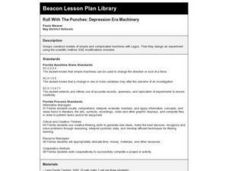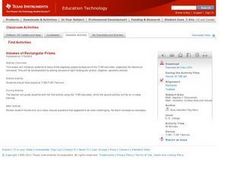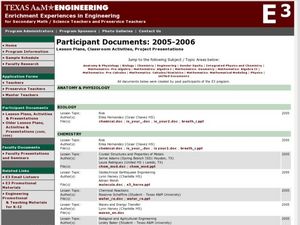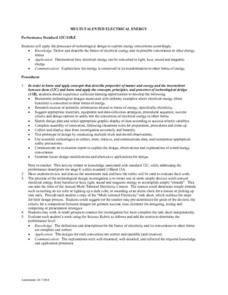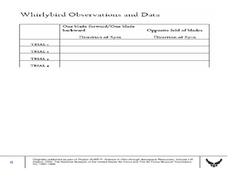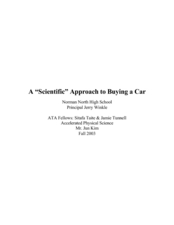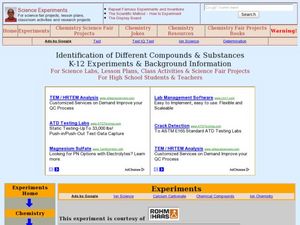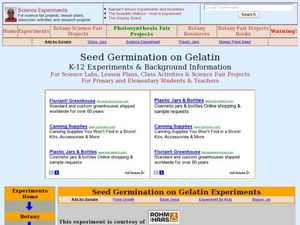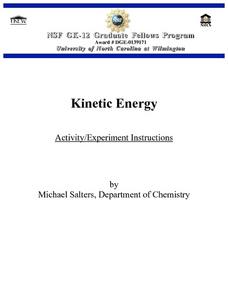Curated OER
The Solar Cycle
Students research the solar cycle. In this Science lesson, students use the internet to investigate the solar cycle. Students produce a spreadsheet and graph from the information collected.
Curated OER
Roll with the Punches: Depression Era Machinery
Students construct models of simple and complicated machines with Legos. Then they design an experiment using the scientific method. ESE modifications included.
Curated OER
Implicit Differentiation
Pupils explore the concept of derivatives. They use implicit differentiation to determine points on a graph where a tangent line is horizontal, vertical, or oblique. Finally, learners find the derivative of a polynomial by...
Curated OER
Volumes of Rectangular Prisms
Students determine the volume of a rectangular prism. They then maximize and minimize the volume given variable side lengths. Finally, they factor the volume equation to determine the side lengths.
Curated OER
Compound Interest
Pupils analyze the variables in the formula of a compound interest. They model the increase or decrease of an investment using compound interest and discuss different compounding periods.
Curated OER
Analyzing Birds and Planes
Students find a variety of topics and subjects in this instructional activity. In the math section of this instructional activity, students graph linear equations and analyze their data. They solve one and two step equations to find the...
Curated OER
THE ROLE OF A CONTROL IN THE EXPERIMENTAL DESIGN
Students study the role of controls. They discuss variables and list conditions, that if not kept the same for both flasks, could effect the outcome of the experiment. They come up with most of the following: Amount and temperature of...
Curated OER
Never Push Your Pendulum
Young scholars investigate the behavior of pendulums and identify the variables that affect it. In this pendulum lesson students complete a lab on pendulums, make conclusions about frequency and the period then conduct a controlled...
Teach Engineering
Android Acceleration
Prepare to accelerate your Android. Pupils prep for the upcoming activity in this third installment of a four-part series. The lesson plan progresses nicely by first introducing different types of acceleration to the class. The teacher...
Curated OER
Multi-Talented Electrical Energy
Young scholars explore energy conversions by demonstrating the conversion of electrical energy into light, heat, sound, and magnetic energy. Students create a simple device that converts electrical energy from batteries to heat, light,...
Curated OER
What's the Rub? It's All About Friction!
Students determine the coefficient of friction for different surfaces. In this physics instructional activity, students identify the factors that affect friction. They collect data and write a formal lab report.
Curated OER
Principles of Flight: Gyrocopter and the Scientific Method
Students explore the concept of the scientific method. In this investigative lesson plan, students investigate which direction the blades will spin on a gyrocopter. Student will practice using the scientific method to complete the...
Curated OER
A “Scientific” Approach to Buying a Car
Young scholars examine what it takes to purchase a car and the resources out there to help find what you are looking for. For this scientific method lesson students complete different problem solving situations.
Curated OER
Modeling Hot and Cold Planets
Young scholars, in teams, design and construct models of two planets, one hot and the other cold, using a variety of materials. They attempt to create the models out of substances that will actually show the greatest temperature...
Curated OER
Paper Airplane Contest
Students research principles of flight. They design their own paper airplanes and make predictions about the performance of different designs. Students keep track of their findings in an electronic journal.
Curated OER
Ziplock Chemistry
Students investigate various chemical reactions when creating mixtures in ziplock baggies. In this chemistry lesson, students will recognize various chemical reactions and cite evidence. Safety and assessment strategies are included in...
Curated OER
With Liberty & Top Soil for All
Middle schoolers compare the basic needs of plants to the basic needs of democracy. In this democracy comparison lesson, students complete a worksheet on what happens to a plant that's not nourished. Middle schoolers draw a correlation...
Curated OER
Identification of Different Compounds and Substances
Students conduct a series of tests to identify unknown compounds. For this chemistry lesson, students compare the physical and chemical properties of substances. They collect data and formulate a conclusion.
Curated OER
Building Polymer Cup Speakers
Students investigate sound waves and they build audio speakers. In this audio speakers and sound lesson, students explore how to make quality audio speakers. As a team they build their own speakers to have clarity in sound, quality in...
Curated OER
Seed Germination on Gelatin
Students examine how seeds germinate in a culture. In this germination lesson students germinate seeds in gelatin and observe the growth of the plant.
Curated OER
Kinetic Energy
Students are able to solve kinetic energy problems. They are introduced to kinetic energy. Students are shown examples of how to solve kinetic energy problems using the formula: Velocity= Distance/Time.
Curated OER
The Case Of The Sour Employee
Ninth graders are presented with a problem that has to be solved. The scenario is a mystery that is purely hypothetical. This does draw on the knowledge of previous lessons. The lesson plan contains background knowledge explaining the...
Curated OER
Trajectory and Range of a Projectile
Students investigate the factors affecting projectile trajectory. In this physics lesson, students calculate the range, time and speed of projectiles using mathematical equations.
Curated OER
The Identification of Bacteria
Students are given a two week period to put to use the knowledge they have gained while studying bacteria. As a culminating activity, students each receive three unknown bacteria to identify.

